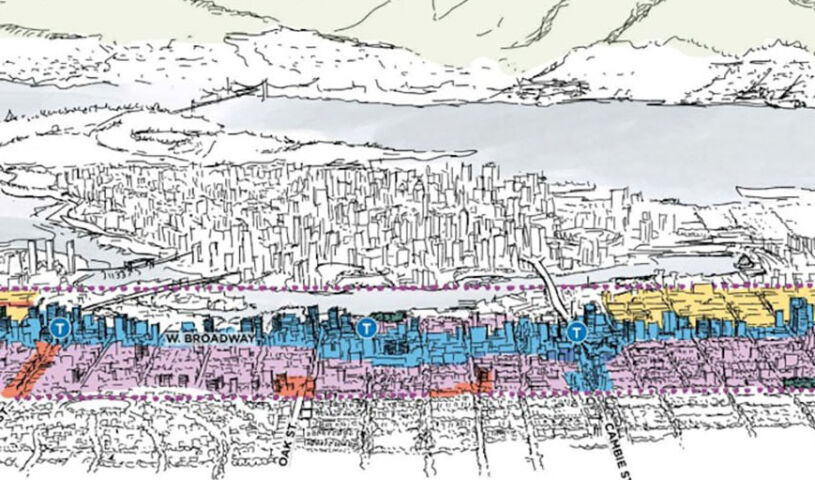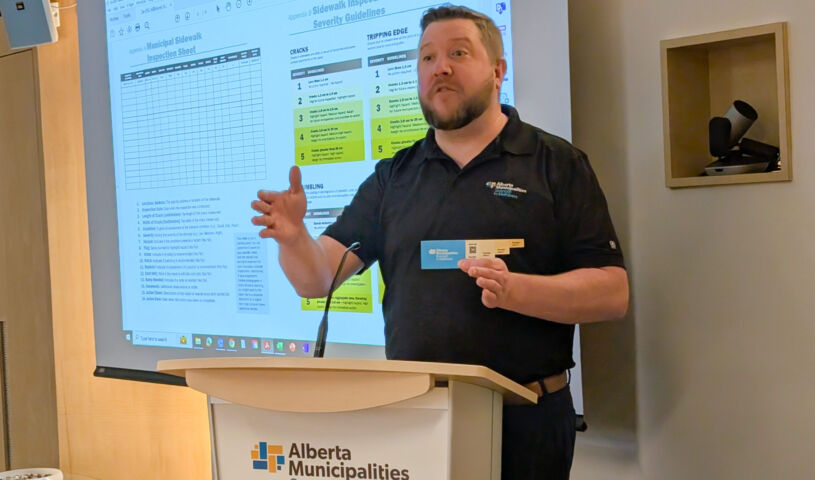Vancouver’s Broadway Plan reflects transit-oriented development trend
 Vancouver’s updated Broadway Plan reflects a trend toward transit-oriented development. Photo: City of Vancouver
Vancouver’s updated Broadway Plan reflects a trend toward transit-oriented development. Photo: City of Vancouver
Vancouver council recently approved updates to the city’s Broadway Plan that will see major construction developments along one of the city’s key roads. The council also adopted the Broadway Public Realm and Streetscape Plan, and the Civic District Plan.
A statement from the city said the approved updates are “an important step in adding essential housing, job space, and amenities that will meet the needs of today’s residents and future generations.”
Currently, there are 139 projects in the development pipeline, which include 15,372 market-rental housing units, 3,549 below-market rental and social housing units, 1,403 strata homeownership units, and over 7.4 million square feet of job space. Over the next 30 years, the Broadway Plan area could see 41,500 net new homes, accommodating up to 64,000 additional residents, 45,000 net new jobs, and 3,000 new hotel rooms.
“This is a major milestone in our commitment to expanding housing choices for all Vancouver residents,” Mayor Ken Sim said. “By integrating housing diversity with transit accessibility, we are paving the way for a more sustainable, inclusive, and vibrant city. These measures will help us meet the housing needs of our residents while fostering complete, connected communities.”
Approved by council in June 2022, the Broadway Plan provides a 30-year framework to integrate new housing, job space, and amenities with the Broadway Subway. The Broadway Plan guides growth and change in the area that is generally located east to west between Clark Drive and Vine Street, and north to south between 1st and 16th Avenue.
It is intended to be flexible so that we can respond to new opportunities and challenges. Change will happen incrementally across the 500 blocks of the Broadway Plan area, prioritizing livability while adding job space and a mix of non-market, rental, and ownership housing around the future Broadway Subway line.
Transit-Oriented Development
Since council first approved the plan in 2022, new provincial legislation on Transit Oriented Areas (TOAs) has required updates to the Broadway Plan. In 2023, B.C. brought in changes to its Local Government Act to promote high-density development near transit stations. The identified zones, called Transit Oriented Development (TOD) Areas, place high-density, mixed-use development within walking distance from frequent transit services.
TOD typically incorporates a variety of land uses, including residential, commercial (such as grocery stores and retail), and community amenities (such as child care and community centres). It is meant to promote more livable and sustainable communities by building more homes near transit and services.
While Vancouver says the Broadway Plan largely aligns with provincial TOA legislation, some changes were needed to fully meet the new requirements. Vancouver council recently approved the following changes:
- increased building heights and densities in certain areas to meet or exceed legislated minimums
- removal of tower limit policies mainly within 400 metres of SkyTrain stations, to comply with legislated height requirements
Existing policies on tower separation, minimum site frontage, and setbacks will continue to regulate the number of towers per block and encourage a range of building types.
Last June, council adopted a new bylaw on transit-oriented areas. The bylaw means developments close to transit stations must meet new minimum density standards. Developments within 200 metres of a Skytrain station must be at least 20 storeys; within 400 metres, up to 12 storeys; and within 800 metres, up to eight storeys. The bylaw also outlines similar requirements for developments near bus exchanges.
The Broadway Plan was developed in co-ordination with the Vancouver Plan, the overarching, strategic land use plan that will guide growth and change for the entire city to 2050.
That plan focuses on what the city calls “Three Big Ideas:” equitable housing and complete neighbourhoods, an economy that works for all, and climate protection and restored ecosystems.
“Through the implementation of the Vancouver Plan, we’re tackling some of the biggest challenges our city faces,” said Josh White, general manager of planning, urban design and sustainability. “This is about creating meaningful change – whether it’s addressing housing affordability, advancing climate action, or supporting vibrant neighbourhoods. We’re committed to delivering results that make Vancouver a better place for everyone.”
San Antonio Adopts Transit-Oriented Policy
In the United States, San Antonio, is a step closer to implementing a rapid transit system after council adopted a new transit-oriented development plan in December.
The plan includes creating three categories of TOD zoning districts that create levels of density; updated standards that protect residential neighbourhoods from incompatible development; outdoor pedestrian space requirements; and a 50 per cent reduction in minimum parking requirements.
Research by the Alamo Area Metropolitan Planning Organization suggests that both congestion and air quality are expected to worsen by 2050, despite planned roadway expansions. In addition, San Antonio is expected to also gain more than a million residents by then.
“To manage traffic and prevent San Antonio from being classified as severe for ozone levels, enhancing transit, bicycle, and pedestrian infrastructure is crucial,” according to a statement from the city.
“The TOD plan emphasizes growth and sustainability,” City Manager Erik Walsh said. “This plan promotes walkable neighbourhoods and convenient transit access for residents.”
The city’s rapid bus transit system will centre around two corridors. The north-south Green Line will link the San Antonio Airport to the Brooks Area and downtown San Antonio and is expected to begin service in 2027-28. A second east-west Silver Line is currently under development with construction projected to begin in 2027.
“Our residents’ day-to-day lives must always be taken into account first,” said council member Marc Whyte. “If done correctly, TOD plans can create vibrant, mixed-use communities.” MW
✯ Municipal World Executive and Essentials Plus Members: You might also be interested in Sean Meyer’s article: Shaping a post-pandemic future through economic development.
Ibrahim Daair is staff writer at Municipal World.
Related resource materials:
- Vancouver bringing in changes to parking fees, regulations
- On-demand transit: Public transportation’s more efficient possibility
- Transit in Metro Vancouver could face major cuts, TransLink warns


